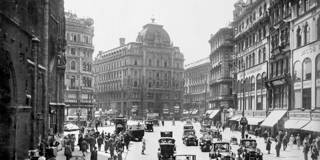Long caricatured as an exponent of reductionist scientism, the interwar Vienna Circle comprised some of Europe's greatest minds. Thanks to a series of excellent reappraisals geared toward a mass audience, the Circle is finally getting the critical appreciation it deserves.
- David Edmonds, The Murder of Professor Schlick: The Rise and Fall of the Vienna Circle, Princeton University Press, 2020.
Wolfram Eilenberger,Time of the Magicians: Wittgenstein, Benjamin, Cassirer, Heidegger, and the Decade that Reinvented Philosophy, Penguin Press, 2020.
Karl Sigmund, Exact Thinking in Demented Times: The Vienna Circle and the Epic Quest for the Foundations of Science, Basic Books, 2017.
Janek Wasserman, Black Vienna: The Radical Right in the Red City, 1918-1938, Cornell University Press, 2014.
TORONTO – For much of the developed world, the decade after World War I is known as the “Roaring Twenties” or the “Jazz Age,” a time of personal excess and economic recovery from the ruins of war. The common view of post-war Berlin and Vienna, however, is very different. There was wanton excess in both cities, of course, but economic life also seemed perpetually precarious.
The story of Weimar Berlin’s decadence leading inevitably to the rise of Hitler and the Third Reich has been repeated to the point of becoming hackneyed – which is not to suggest that it was ever true. By contrast, interwar Vienna’s history is less well known and overdue for incisive diagnosis.
John Maynard Keynes painted an early portrait of Vienna in these years, when he tried – unsuccessfully – to persuade WWI’s victors to lower the price of the peace for the losers. Following the dismemberment of the Austro-Hungarian Empire, Keynes saw the Vienna of 1919 as a place of “famine, cold, disease, war, murder, and anarchy.” Inflation was out of control, he noted, and the 1918 influenza pandemic had heaped more bodies on top of the pile of war dead.

Wolfram Eilenberger,Time of the Magicians: Wittgenstein, Benjamin, Cassirer, Heidegger, and the Decade that Reinvented Philosophy, Penguin Press, 2020.
Karl Sigmund, Exact Thinking in Demented Times: The Vienna Circle and the Epic Quest for the Foundations of Science, Basic Books, 2017.
Janek Wasserman, Black Vienna: The Radical Right in the Red City, 1918-1938, Cornell University Press, 2014.
TORONTO – For much of the developed world, the decade after World War I is known as the “Roaring Twenties” or the “Jazz Age,” a time of personal excess and economic recovery from the ruins of war. The common view of post-war Berlin and Vienna, however, is very different. There was wanton excess in both cities, of course, but economic life also seemed perpetually precarious.
The story of Weimar Berlin’s decadence leading inevitably to the rise of Hitler and the Third Reich has been repeated to the point of becoming hackneyed – which is not to suggest that it was ever true. By contrast, interwar Vienna’s history is less well known and overdue for incisive diagnosis.
John Maynard Keynes painted an early portrait of Vienna in these years, when he tried – unsuccessfully – to persuade WWI’s victors to lower the price of the peace for the losers. Following the dismemberment of the Austro-Hungarian Empire, Keynes saw the Vienna of 1919 as a place of “famine, cold, disease, war, murder, and anarchy.” Inflation was out of control, he noted, and the 1918 influenza pandemic had heaped more bodies on top of the pile of war dead.